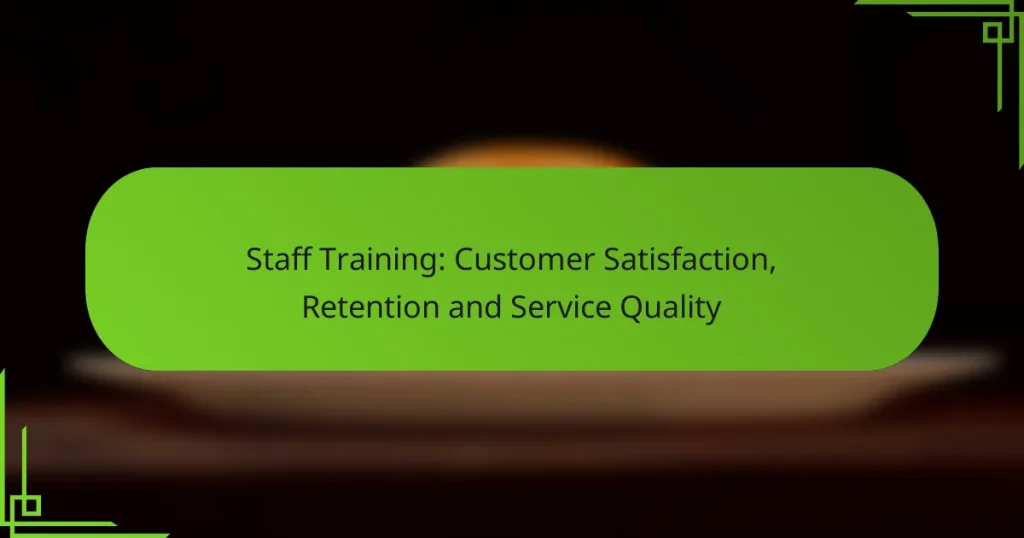Staff training plays a crucial role in boosting customer satisfaction and retention by providing employees with the necessary skills to deliver high-quality service. By implementing effective training programs, businesses can ensure their staff is well-equipped to meet customer needs, fostering loyalty and enhancing their overall reputation. This investment in employee development not only improves service interactions but also contributes to long-term success in a competitive market.

How can staff training improve customer satisfaction in Los Angeles?
Staff training can significantly enhance customer satisfaction in Los Angeles by equipping employees with essential skills and knowledge. This leads to better service quality, increased customer loyalty, and a positive reputation for businesses in the area.
Enhanced communication skills
Improving communication skills is vital for staff to effectively interact with customers. Training programs can focus on active listening, clear articulation, and appropriate body language, which are essential for understanding customer needs and responding appropriately.
For instance, role-playing scenarios can help staff practice handling various customer interactions, from inquiries to complaints. This hands-on approach fosters confidence and ensures that employees can communicate effectively in real situations.
Increased product knowledge
Comprehensive product knowledge enables staff to provide accurate information and recommendations to customers. Training should cover product features, benefits, and common issues, allowing employees to address customer queries competently.
In Los Angeles, where diverse products and services are available, staff should be familiar with local trends and preferences. Regular updates and refresher courses can keep employees informed about new offerings and changes in the market.
Empathy training
Empathy training helps staff understand and relate to customer emotions, which is crucial for building rapport. Programs should teach employees to recognize customer feelings and respond with sensitivity, enhancing the overall customer experience.
For example, training can include exercises that encourage staff to put themselves in the customer’s shoes, fostering a culture of understanding and care. This approach can lead to more personalized interactions and improved customer satisfaction.
Personalized service techniques
Personalized service techniques involve tailoring interactions to meet individual customer needs. Training should emphasize the importance of remembering customer preferences and using their names to create a welcoming atmosphere.
In a competitive market like Los Angeles, personalized service can set a business apart. Staff can be trained to use customer data effectively, such as purchase history, to offer tailored recommendations and enhance the overall experience.

What are effective staff training programs for service quality?
Effective staff training programs for service quality focus on enhancing employees’ skills and knowledge to improve customer interactions. These programs typically include structured training sessions, hands-on workshops, and practical exercises to ensure staff can deliver exceptional service consistently.
Service Excellence Training
Service excellence training aims to instill a culture of high-quality service among employees. This training often covers key principles such as empathy, active listening, and problem-solving, which are essential for meeting customer needs. Programs may include assessments to measure understanding and application of these principles in real-world scenarios.
Consider incorporating feedback mechanisms, such as customer surveys, to evaluate the effectiveness of the training. Regularly updating the training content based on customer feedback can help maintain high service standards.
Customer Experience Workshops
Customer experience workshops are interactive sessions designed to enhance employees’ understanding of the customer journey. These workshops typically involve analyzing customer touchpoints and identifying areas for improvement. Engaging employees in discussions about their experiences can foster a sense of ownership and accountability for service quality.
Utilizing tools like journey mapping can help visualize the customer experience and highlight critical moments that impact satisfaction. Encourage participants to brainstorm solutions to common pain points, promoting a proactive approach to service delivery.
Role-playing scenarios
Role-playing scenarios are a practical training method that allows staff to practice handling various customer interactions in a controlled environment. This technique helps employees develop their communication and problem-solving skills while receiving immediate feedback from trainers and peers. Scenarios can range from handling complaints to upselling products.
To maximize the effectiveness of role-playing, ensure that scenarios reflect real-life situations relevant to your business. Encourage participants to switch roles to gain different perspectives, enhancing their understanding of customer needs and expectations.

How does staff training impact customer retention?
Staff training significantly enhances customer retention by equipping employees with the skills needed to deliver exceptional service. Well-trained staff can effectively address customer needs, leading to increased satisfaction and loyalty.
Building customer loyalty
Training programs that focus on customer service skills help employees understand the importance of creating positive experiences. When staff members are knowledgeable and confident, they can foster strong relationships with customers, encouraging repeat business.
Consider implementing role-playing scenarios during training to simulate customer interactions. This hands-on approach allows employees to practice resolving issues and exceeding expectations, which can lead to higher loyalty rates.
Reducing employee turnover
Effective training can reduce employee turnover by increasing job satisfaction and engagement. When employees feel competent in their roles, they are less likely to seek employment elsewhere, which in turn stabilizes customer relationships.
To minimize turnover, ensure that training includes ongoing support and development opportunities. Regular feedback and recognition can motivate staff to stay committed to the company and its customers.
Creating brand advocates
Trained employees are more likely to become brand advocates, promoting the business through positive interactions. When staff members are passionate and knowledgeable, they can effectively communicate the brand’s values and benefits to customers.
Encourage employees to share their experiences and insights during training sessions. This not only builds camaraderie but also empowers them to represent the brand authentically, turning satisfied customers into advocates who refer others.

What metrics measure the success of staff training?
Success in staff training can be measured through various metrics that reflect customer satisfaction, employee performance, and retention rates. These indicators provide insights into how well training programs are enhancing service quality and meeting organizational goals.
Customer feedback scores
Customer feedback scores are crucial for assessing the impact of staff training on service quality. These scores can be gathered through surveys, online reviews, and direct feedback forms, typically focusing on areas such as service speed, staff friendliness, and overall satisfaction.
To effectively use customer feedback scores, organizations should establish a consistent method for collecting and analyzing this data. Aim for a response rate of at least 20-30% to ensure the feedback is representative. Regularly reviewing these scores can help identify trends and areas needing improvement.
Employee performance evaluations
Employee performance evaluations provide a structured way to assess how well staff apply their training in real-world scenarios. These evaluations often include metrics such as task completion rates, customer interactions, and adherence to company standards.
Implementing a regular evaluation schedule, such as quarterly or bi-annually, can help track progress over time. Consider using a combination of self-assessments and manager reviews to gain a comprehensive view of employee performance. This dual approach encourages accountability and personal growth.
Retention rates
Retention rates indicate how well an organization retains its employees, which can be influenced by effective training programs. High retention rates often correlate with increased employee satisfaction and a positive work environment, both of which are fostered by comprehensive training initiatives.
To monitor retention, calculate the percentage of employees who remain with the company over a specific period, typically annually. Aim for retention rates above 80% in service-oriented industries, as high turnover can indicate issues with training or workplace culture. Regularly review exit interviews to identify training-related concerns that may contribute to employee departures.

What prerequisites are needed for effective staff training?
Effective staff training requires clear objectives, management support, and adequate resources. These elements ensure that training programs are focused, supported, and equipped to meet the needs of both employees and the organization.
Clear training objectives
Establishing clear training objectives is essential for guiding the training process. Objectives should be specific, measurable, achievable, relevant, and time-bound (SMART) to provide a clear direction for both trainers and participants.
For example, instead of a vague goal like “improve customer service,” a clear objective might state, “reduce customer complaint response time by 30% within six months.” This specificity helps measure success and adjust training as needed.
Management support
Management support is crucial for the success of any training initiative. When leaders actively endorse and participate in training programs, it signals to staff that the organization values their development and the importance of customer satisfaction.
To foster this support, management can allocate time for training, provide feedback, and recognize employees’ efforts in applying new skills. This involvement not only boosts morale but also enhances the overall effectiveness of the training.
Resource allocation
Proper resource allocation is vital for effective staff training. This includes financial resources, training materials, and access to technology. Organizations should budget appropriately to ensure that training programs are comprehensive and engaging.
For instance, investing in online training platforms or hiring experienced trainers can significantly enhance the quality of the training. Additionally, providing employees with time during work hours to participate in training can improve attendance and engagement.


